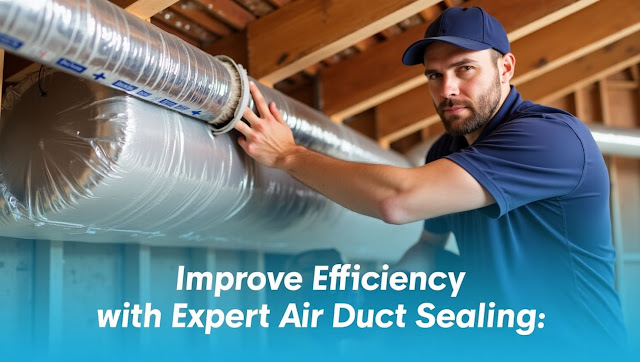When was the last time you thought about your home's air ducts? Probably never—unless something went wrong. But here’s the truth: air duct sealing plays a major role in your home’s energy efficiency, indoor air quality, and overall comfort. Whether you’re dealing with fluctuating temperatures, rising energy bills, or dusty indoor air, your ductwork may be the culprit.
At Air Duct Sealing, we believe in solving the invisible problems hiding behind your walls and ceilings. This article explains what air duct sealing is, why it matters, how it's done, and what it means for homeowners and businesses alike.
What Is Air Duct Sealing?
Air duct sealing is the process of closing gaps, cracks, and leaks in your HVAC ductwork system. These leaks can occur over time due to poor installation, age, or damage from rodents, construction, or corrosion.
Leaky ducts can allow conditioned air (either cooled or heated) to escape before it reaches its destination. This leads to inefficiency, uneven temperatures, and wasted energy.
Duct sealing typically involves one of the following methods:
- Mastic sealant: A thick paste applied manually to the duct joints.
- Foil-backed tape: High-quality HVAC tape (not common duct tape!) used to seal seams.
- Aerosol-based sealing (Aeroseal): A pressurized fog of polymer particles blown into the system to seal leaks from the inside.
Why Is Air Duct Sealing So Important?
The U.S. Department of Energy reports that 20% to 30% of the air that moves through duct systems is lost due to leaks, holes, and poor connections. That’s nearly a third of your HVAC system’s hard work—gone.
Let’s break down why sealing your ducts matters:
1. Energy Efficiency
Unsealed ducts waste energy by leaking air into crawl spaces, attics, or behind walls. When ducts are sealed, your HVAC system doesn’t have to work as hard, which translates to lower utility bills.
2. Comfort
Leaky ducts often cause hot and cold spots in rooms. Sealing ensures that every room gets the right amount of airflow.
3. Indoor Air Quality
Leaks pull in dust, insulation fibers, and pollutants from unconditioned spaces. These particles then circulate through your home. Sealing ducts helps reduce respiratory irritants and allergens.
4. HVAC Longevity
When your system doesn’t have to overcompensate for lost air, its lifespan increases, and maintenance issues are reduced.
5. Environmental Impact
Reducing wasted energy helps shrink your carbon footprint, making your home more eco-friendly.
Real Impact: Sealed vs. Unsealed Ducts
| Feature | Unsealed Ducts | Sealed Ducts |
|---|---|---|
| Energy Usage | High energy consumption | Lower energy bills |
| Temperature Consistency | Uneven room temperatures | Balanced comfort throughout home |
| Dust and Allergens | Frequently present in air | Significantly reduced |
| HVAC Strain | Overworked systems | Efficient system performance |
| Environmental Efficiency | Increased carbon emissions | Reduced environmental impact |
A Word from the Experts
“Sealing your ducts is one of the most cost-effective steps you can take to boost energy performance and improve air quality in your home.”
How Does Air Duct Sealing Work?
At Air Duct Sealing, we follow a proven step-by-step process:
Step 1: Inspection
We start with a full inspection of your ductwork using specialized equipment to detect air loss, pressure levels, and leakage points.
Step 2: Leak Detection
Using pressure tests and thermal imaging, we pinpoint problem areas in your duct system—whether in attics, basements, or inside walls.
Step 3: Sealing
We apply industry-grade mastic or Aeroseal products to seal leaks. The choice depends on the location, severity of leaks, and your HVAC layout.
Step 4: Testing & Results
After sealing, we retest your system to confirm that leakage is within acceptable limits—and show you the before and after data.
When Should You Consider Duct Sealing?
You might not see your ducts, but here are some clear signs they need attention:
- Rooms that are too hot or too cold
- High monthly energy bills
- Excess dust in the home
- Musty odors when the HVAC runs
- Noisy ducts or airflow issues
- Visible signs of loose or disconnected ducts
If you’ve experienced any of the above, it’s time to reach out to Air Duct Sealing for an assessment.
Frequently Asked Questions (FAQs)
Q: Is air duct sealing messy or invasive?
A: Not at all. Most modern sealing processes, like Aeroseal, are clean and require no tearing into walls. For accessible ducts, sealing can be completed in a matter of hours.
Q: How long does air duct sealing last?
A: Properly sealed ducts can last 10–15 years or longer, especially when using high-grade materials like Aeroseal polymers or mastic.
Q: Is duct sealing worth the cost?
A: Yes. Most homeowners recover the cost in energy savings within 2–3 years, not to mention improved comfort and air quality.
Q: Can I seal ducts myself?
A: DIY sealing is possible for exposed ducts, but for full-system effectiveness, especially with hidden ductwork, professional services are recommended.
Q: How do I know if my ducts are leaking?
A: A professional airflow and pressure test can determine duct leakage. If your energy bills are high or some rooms don’t heat/cool evenly, those are good indicators.
Final Thoughts
Air duct sealing is one of the most overlooked upgrades in residential and commercial HVAC systems. Yet, it delivers immediate and long-term benefits—improving your comfort, health, and wallet all at once.
Whether you're building a new home, upgrading your HVAC, or just tired of dusty air and high bills, sealing your ducts is a smart, effective move.
At Air Duct Sealing, we help you unlock the full potential of your HVAC system. Our trained professionals use the latest tools and technology to ensure airtight performance and satisfaction.
Read More : Airduct Mold Cleaning





0 Comments